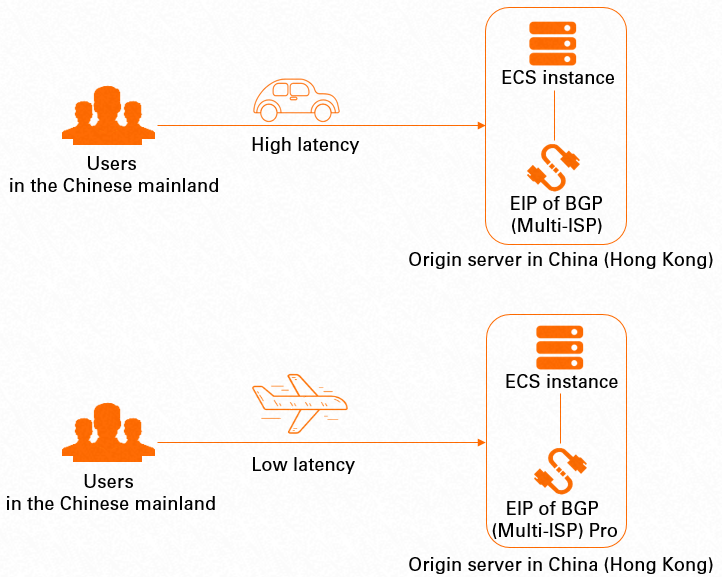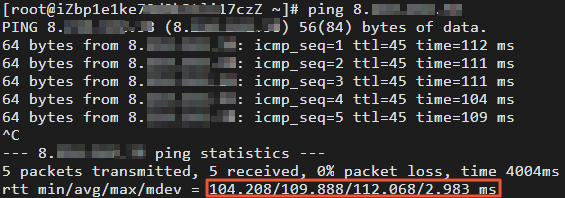Due to ISP regulations and international connection congestion, users in the Chinese mainland may not be able to access services in China (Hong Kong) or other regions outside the Chinese mainland. The connections are usually slow even if the services can be accessed. BGP (Multi-ISP) Pro elastic IP addresses (EIPs) optimize data transmission to the Chinese mainland and improve connection quality for services in China (Hong Kong) or international services.
Background information
BGP (Multi-ISP) Pro lines optimize data transmission to the Chinese mainland and improve connection quality for international services. Compared with BGP (Multi-ISP), when BGP (Multi-ISP) Pro lines provide services to users in the Chinese mainland (excluding data centers), cross-border connections are established by using Chinese mainland ISP services. This reduces network latency.
The following regions support BGP (Multi-ISP) Pro EIPs: China (Hong Kong), Japan (Tokyo), Singapore, Malaysia (Kuala Lumpur), Philippines (Manila), Indonesia (Jakarta), and Thailand (Bangkok).
BGP (Multi-ISP) Pro lines support only the pay-as-you-go billing method in the following regions: Japan (Tokyo), Singapore, Malaysia (Kuala Lumpur), Philippines (Manila), Indonesia (Jakarta), and Thailand (Bangkok).
Sample scenario
The following scenario is used in this topic. A web service is deployed on an Elastic Compute Service (ECS) instance in the China (Hong Kong) region. The ECS instance is associated with a BGP (Multi-ISP) EIP. Network latency is high when users in the Chinese mainland access the web service deployed in the China (Hong Kong) region. 
You can associate a BGP (Multi-ISP) Pro EIP with the ECS instance. Then, users in the Chinese mainland can access the web service deployed in the China (Hong Kong) region without using international ISP services. This reduces network latency.
Prerequisites
A web service is deployed on an ECS instance in the China (Hong Kong) region. The ECS instance is deployed in a VPC. For more information, see Create an instance by using the wizard.
Procedure

Step 1: Purchase a BGP (Multi-ISP) Pro EIP
The following example describes how to purchase a BGP (Multi-ISP) Pro EIP that is billed on a pay-as-you-go basis.
- Log on to the Elastic IP Address console .
On the Elastic IP Addresses page, click Create EIP.
On the EIP page, set the following parameters for the EIP, click Buy Now, and then complete the payment.
Parameter
Description
Billing Method
Select a billing method for the EIP.
In this example, Pay-as-you-go is selected.
Region
Select the region where you want to create the EIP.
In this example, China (Hong Kong) is selected.
Line Type
Select a line type for the EIP.
In this example, BGP (Multi-ISP) Pro is selected.
Network Type
Select a network type for the EIP.
Only Internet is supported.
Security Protection
Select an edition of Anti-DDoS based on your business requirements.
In this example, Default is selected.
IP Address Pool
Select an IP address pool.
In this example, Default is selected.
Data Transfer
Select a metering method for data transfer over the EIP.
In the example, Pay-By-Bandwidth is selected.
Maximum Bandwidth
Specify a maximum bandwidth value for the EIP.
In this example, 1 Mbps is specified.
Name
Enter a name for the EIP.
Resource Group
Select the resource group to which the EIP belongs.
Billing Cycle
Select a billing cycle for the EIP.
You can select only Day for a pay-by-bandwidth EIP.
Quantity
Select the number of EIPs that you want to purchase.
In this example, 1 is specified.
Click Console and return to the Elastic IP Addresses page.
After you return to the Elastic IP Addresses page, you can view the BGP (Multi-ISP) Pro EIP.
Step 2: Associate the EIP with an ECS instance
After you create an EIP, you can associate the EIP with an ECS instance in a VPC. After the EIP is associated with an ECS instance, the ECS instance can communicate with the Internet.
On the Elastic IP Addresses page, find the EIP that you created in Step 1: Purchase a BGP (Multi-ISP) Pro EIP and click Associate with Resource in the Actions column.
In the Associate EIP with Resource dialog box, set the following parameters and click OK to associate the EIP with the ECS instance.
Parameter
Description
Instance Type
Select the type of the instance with which you want to associate the EIP.
In this example, ECS Instance is selected.
Select an instance to associate.
Select the ECS instance to be associated with the EIP.
Step 3: Test the network latency
After you associate the EIP with the ECS instance, you can test the network latency between a client in the Chinese mainland and the ECS instance that is deployed in the China (Hong Kong) region.
A client that runs Linux is used in this example. The command that is used to verify the connectivity varies based on the operating system that you use. For more information, see the user guide of your operating system.
The test result in this example is for reference only. The actual network latency varies based on the network quality of the ISP for the BGP (Multi-ISP) Pro EIP.
Open the CLI on an on-premises machine that is deployed in the Chinese mainland.
Run the
pingcommand to test the network latency between the client and the ECS instance associated with the EIP.Run the following command to test the network latency between the client and the ECS instance when the ECS instance is associated with the BGP (Multi-ISP) EIP.
ping <IP address of the BGP (Multi-ISP) EIP>Figure 1. Network latency when the ECS instance is associated with the BGP (Multi-ISP) EIP

Run the following command to test the network latency between the client and the ECS instance when the ECS instance is associated with the BGP (Multi-ISP) Pro EIP.
ping <IP address of the BGP (Multi-ISP) Pro EIP>Figure 2. Network latency when the ECS instance is associated with the BGP (Multi-ISP) Pro EIP

The test result shows that the network latency between the client in the Chinese mainland and the ECS instance is reduced when the ECS instance is associated with the BGP (Multi-ISP) Pro EIP.
FAQ
Why am I unable to associate an EIP with an ECS instance?
Possible causes:
The EIP and ECS instance do not belong to the same region.
The ECS instance is assigned a public IP address or is associated with another EIP.
The ECS instance is deployed in a classic network instead of a VPC. You can associate an EIP with only an ECS instance that is deployed in a VPC.
The ECS instance is in a state that does not allow you to associate an EIP. You can associate an EIP with an ECS instance that is only in the Running or Stopped state.
To troubleshoot the issue, perform the following operations:
Check the regions in which the EIP and the ECS instance are deployed. Make sure that they are deployed in the same region, for example, in the China (Hangzhou) region.
Log on to the ECS console and check the status of the ECS instance. Make sure that the following requirements are met:

Number
Description
1
The ECS instance is assigned only a private IP address.
As shown in the following figure, if your ECS instance is assigned a public IP address or is associated with another EIP, you cannot associate the EIP with your ECS instance.
 If you have other requirements, see the following topics:
If you have other requirements, see the following topics:2
The ECS instance is deployed in a VPC.
If the ECS instance is deployed in a classic network, you can migrate the ECS instance to a VPC. For more information, see Migrate ECS instances from a classic network to a VPC.
3
The ECS instance is in the Running or Stopped state.
For more information about how to manage the status of your ECS instance, see Instance lifecycle.
Why am I unable to view the EIP in the operating system of the ECS instance after I associate the EIP with the ECS instance?
EIPs are deployed on the Internet gateway of Alibaba Cloud and are mapped to the private network interface controllers (NICs) of the associated ECS instances through NAT. Therefore, you cannot view the EIP on the private NIC of the ECS instance.
You can expose an EIP by adding a secondary CIDR block to a VPC. For more information, see Expose an EIP on an NIC by adding a secondary CIDR block to a VPC.
References
AllocateEipAddress: applies for an EIP.
AssociateEipAddress: associates an EIP with an instance in the same region.